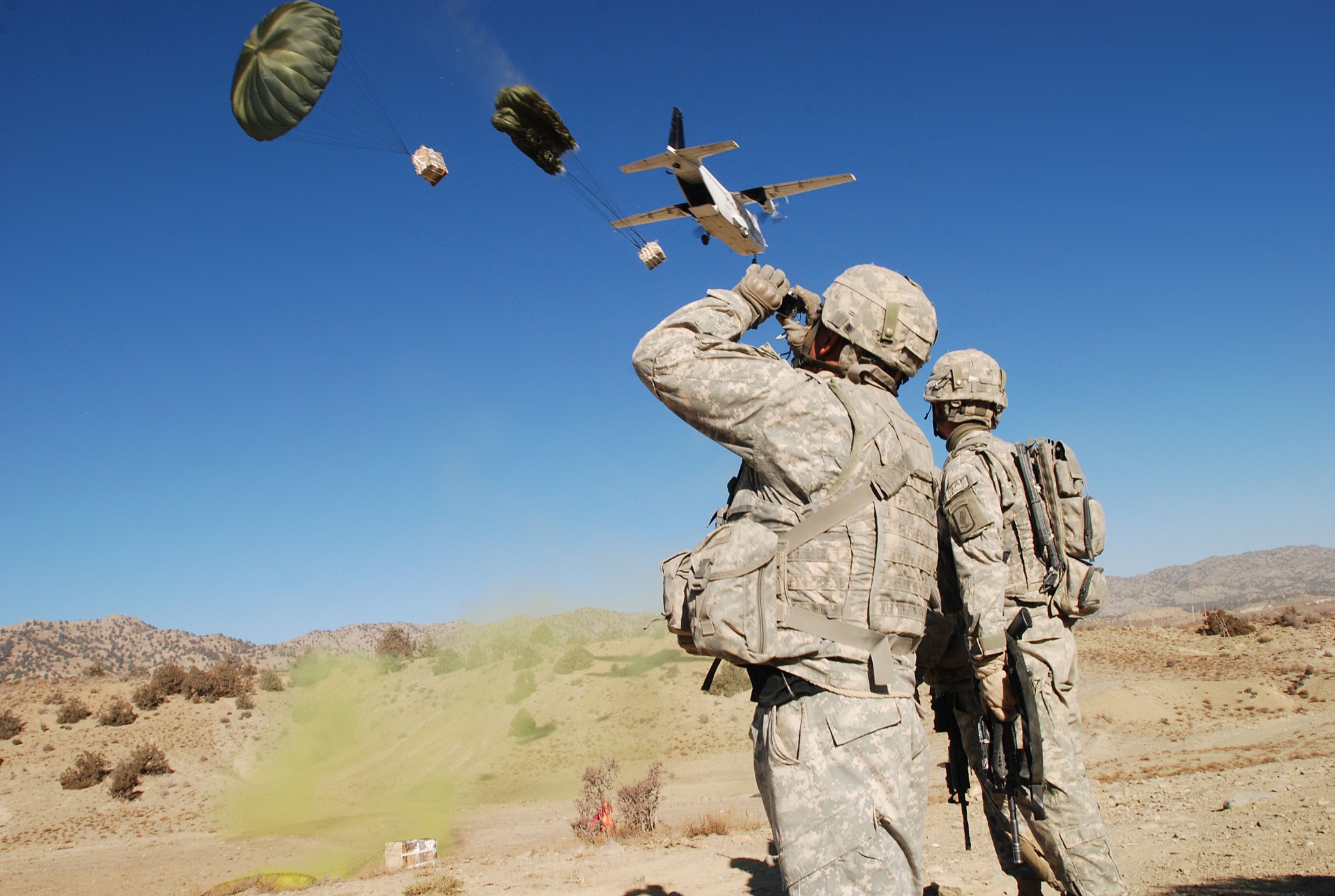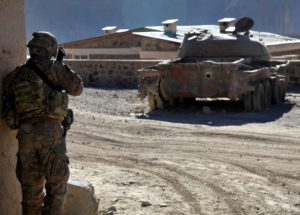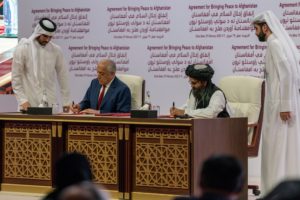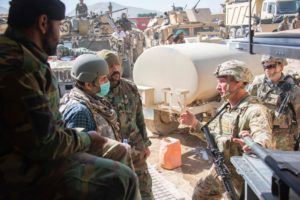 CC Image Courtesy of the U.S. Army
CC Image Courtesy of the U.S. Army
A Rock and a Hard Place: American Forces Leaving Afghanistan
On July 13, the U.S.- Taliban peace deal reached Day 135 of the Doha agreement that will remove American forces from Afghanistan. In recent weeks, new developments, including alleged Russian bounties and increased violence against Afghan forces, further risk derailing the peace process. While the U.S. continues to uphold its end of the deal, it appears to be stuck between a rock and a hard place. Should the U.S. continue adhering to the February Doha agreement while the Taliban has not met its stipulations? The U.S. requires a comprehensive approach to ensure American troops can eventually safely depart the country.
The Latest
Russian Bounties
In late June, a series of allegations suggested Russian intelligence offered Taliban militants bounties for targeting coalition forces, including American troops. While U.S. and Afghan officials have accused Russia of providing the Taliban with arms in the past, the latest accusations illustrate an escalation in strategy. Russia’s military intelligence agency, the GRU, is suspected of having its Unit 29155 orchestrate the plans. The aggressive unit was also responsible for an attempted coup in Montenegro and efforts to poison former GRU officers abroad.
The U.S. Government intercepted what it believes are financial transfers from the GRU intended for the Taliban, which corroborates intelligence obtained through interrogations. Conflicting reports from within the Intelligence Community suggests there are varying levels of confidence regarding the bounties. However, U.S. military officials have been suspicious of Russia financially backing the Taliban since 2017. Russia’s support of the Taliban may be directed at “harassing and embarrassing the U.S. as the troops leave,” similar to how the U.S. acted when the Soviet Union left Afghanistan in the 1980s. Russia and the Taliban have both denied the allegations.

A U.S. Army soldier provides security near an old Russian tank in the Daymirdad District, Wardak province, Afghanistan, Jan. 9, 2011. (Photo Credit: U.S. Army photo by Sgt. Sean P. Casey)
Uptick in Violence
In recent months, the Taliban has engaged in high levels of violence throughout Afghanistan. Taliban attacks rose almost 40% from March through June, compared to the same time frame in 2019. The peace deal may have emboldened the group, which is evident in the assassination attempts against high-ranking Afghan officials and religious scholars. On July 13, the group launched an assault against an Afghan intelligence complex. The attack killed 11 security forces and wounded 63 others, in a move that shifts away from typical Taliban tactics of targeting rural areas. From the recent series of attacks, the Taliban may be testing its limits before provoking an American and allied response.
Intra-Afghan Negotiations
Intra-Afghan negotiations have yet to begin as neither side has released the designated number of prisoners necessary to begin formal talks. To date, the Afghan Government has released 4,400 of 5,000 Taliban prisoners, while the Taliban has released 845 of 1,000 Afghan security forces. The Afghan Government has yet to release the final 600 Taliban prisoners it believes are too dangerous, but the Taliban remains adamant about not straying from the initially negotiated list. The United Nations Special Representative for Afghanistan, Deborah Lyons, states the talks should begin later this month.

Afghan and Taliban representatives signing the landmark deal in Doha, Qatar, on February 29, 2020. (Photo Credit: State Department photo by Ron Przysucha)
Honoring Commitments
On July 13, the U.S. announced it reduced its troop presence in Afghanistan from roughly 12,000 down to the agreed-upon 8,600, effectively closing 5 military bases. The U.S. continues to honor its commitments, but Commander of the U.S. Central Command (CENTCOM) General Kenneth “Frank” McKenzie has stated that the Taliban is not fulfilling its obligations. While the Taliban has not recently attacked American or NATO troops, assaults on Afghan forces have skyrocketed. Additionally, it appears the group is keeping local connections with al-Qaeda, a clear violation of the agreement—and the very reason the U.S. is in Afghanistan in the first place. Both issues highlight the growing concern of what will transpire once American troops fully vacate Afghanistan.

A U.S. Army medic shares tips with his Afghan National Army counterparts during an Afghan-led operation near Kabul, Afghanistan, Sept. 16, 2018. (Photo Credit: U.S. Army photo by Sean Kimmons)
Policy Suggestions
Recent developments place the U.S in a tough position; the U.S. does not want to appear weak by giving the Taliban (or Russia) what it wants through a full removal of U.S. troops from Afghanistan without the Taliban upholding its end of the deal. However, the U.S. does not want to prolong what has been the longest, most costly war it has engaged in. What should the U.S. do?
First, the U.S. must signal that targeting its forces, or its allies, will not be tolerated in any circumstances. The U.S. needs to condemn any alleged actions by Russia and the Taliban. A lack of response not only tells American adversaries it is acceptable to orchestrate and follow through with such tactics, but it also fails to demonstrate support for the American troops in harm’s way.
Second, until the Taliban demonstrates it is meeting the conditions agreed to at the Doha peace signing, the U.S. should pause troop removal. The U.S. has demonstrated its promises, but the Taliban has not. The U.S. should ensure all parties are abiding by the stipulations agreed to before further withdrawal.
Third, until the U.S. Government can agree on whether or not Russia placed bounties on American troops, it should sit pat. To develop a coherent response to the alleged actions, the U.S. Government must first decide if Russia is responsible for the targeted attacks. Should the U.S. decide Russia funded attacks on American forces, it must be responded to swiftly and coherently. Potential recourses include moving more American troops into neighboring NATO countries, increasing naval patrols in the Black Sea, or increasing targeted sanctions against Putin’s inner circle.
Fourth, the U.S. should seek ways to retain influence in Afghanistan after withdrawal. To assist in the inevitable power struggle that will ensue after U.S. withdrawal, the U.S. will need strong relations with the Afghan Government. Backing Afghan forces through continued military training and aid would demonstrate the U.S.’ commitment to supporting the Afghan Government and grant the U.S. political influence for conducting counterterrorism missions. The U.S. will also need a way to independently conduct further counterterror missions in-country if a threat arises.
For the U.S. to stay committed to the peace deal, the Taliban will have to reach the agreement originally set. Should the U.S. find that the Taliban is not, it can—and should—pull out of the peace deal. The U.S. wants to leave Afghanistan but should not rush if the agreed-upon conditions are not met.





